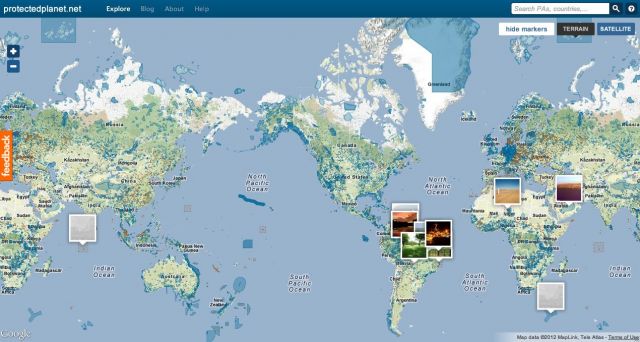 Credit: Tiago Fioreze via Wikimedia Commons.
Credit: Tiago Fioreze via Wikimedia Commons.
In case it sometimes feels like we’ve never done anything good for the wild parts of our planet, take a look at these stats from the World Database on Protected Areas (WDPA).
My piece, “Can One Incredibly Stubborn Person Save a Species?” is about one conservation success story: Mexican biologist Enriqueta Velarde, who has singlehandedly brought two bird species back from the brink of extinction on an Island off the coast of Mexico. Happily, Velarde’s story is part of a larger trend. Since 1872 we’ve take a once radical idea—preserving nature—and scaled it up globally with amazing speed.
 Credit: World Database on Protected Areas
Credit: World Database on Protected Areas
According to the WDPA:
- As of 2008 there are >120,000 protected areas covering a total of about 8 million square miles (~21 million square kilometers) of land and sea
- That’s an area more than twice the size of Canada
- Terrestrial protected areas cover 12.2 percent of the Earth’s land area
- Marine protected areas cover 5.9% of Earth’s territorial seas and 0.5% of extraterritorial seas
 Credit: World Database on Protected Areas
Credit: World Database on Protected Areas
There’s still much variation from nation to nation:
- Only 45 percent of 236 assessed countries and territories have >10 percent of their terrestrial areas protected
- Only 14 percent of 236 assessed nations have >10 percent of their marine areas protected
And there’s still a long way to go to meet targets set by the Convention on Biological Diversity:
- By 2009 only half the world’s 821 ecoregions were >10 percent protected
- Less than 20 percent of the world’s 232 marine ecoregions were >10 percent protected
- While nearly 10 recent of land ecoregions had <1 percent protected
- And more than 50 percent of marine ecoregions had <1 percent protected
Yet the trend remains positive. Ecoregions deemed most important for preserving biodiversity increased in total protection from 19-25 percent in 1990 to 26-35 percent in 2007.

Credit: World Bank, Development Education ProgramAnd when you set this exponential trend towards protection against the exponential growth in our population since the Industrial Age—with all its exponentially increasing pressures to exploit not protect—then this revolutionary advance in human thinking becomes all the more impressive.
Each one of these hard-won protections for the natural world sustains us more than it costs us.
 Credit: ProtectedPlanet.net/World Database on Protected Areas
Credit: ProtectedPlanet.net/World Database on Protected Areas
The World Database of Protected Areas has created an interactive website where you can see what’s protected where.
And check out their ProtectedPlanetOcean to interact with the marine waters granted some measure of preservation.






